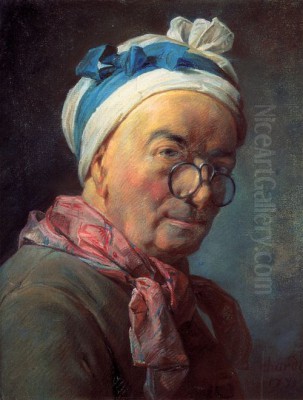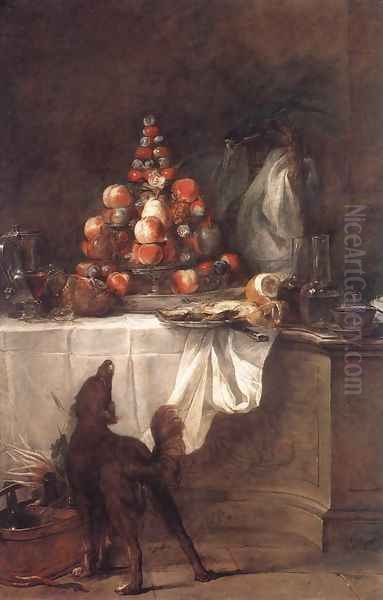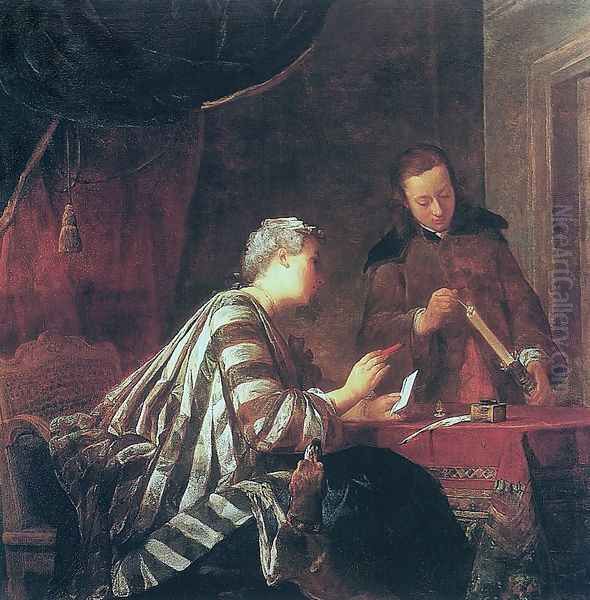
Jean-Baptiste-Siméon Chardin stands as one of the most esteemed and distinctive painters of 18th-century France. Born in Paris on November 2, 1699, and passing away in the same city on December 6, 1779, Chardin dedicated his artistic life to the quiet observation and masterful rendering of the everyday world. Unlike many of his contemporaries drawn to the flamboyant Rococo style, Chardin found profound beauty in simplicity, elevating still life and genre scenes to unprecedented levels of sensitivity and realism. His work continues to resonate for its technical brilliance, its tranquil atmosphere, and its deep humanity.
Early Life and Artistic Formation
Chardin emerged from humble beginnings in Paris. His father was a skilled cabinetmaker, a background that perhaps instilled in the young Chardin an appreciation for craftsmanship and the tangible quality of objects. This environment, focused on the creation of functional yet beautiful items for domestic life, likely influenced his later artistic focus on the textures, forms, and quiet dignity of household goods and settings. His formal training was relatively limited compared to the extensive academic paths of some peers.
He initially apprenticed with Pierre-Jacques Cazes, a painter of historical subjects. This early exposure to a more traditional academic style provided a foundation, but it was not the direction Chardin would ultimately pursue. He later spent time in the studio of Noël-Nicolas Coypel, another history painter. However, accounts suggest that Chardin's most significant development came through his own diligent study and practice, particularly his close observation of the world around him and his analysis of paintings by earlier masters. He was, in many respects, largely self-taught, honing his unique vision through personal exploration rather than strict adherence to academic formulas.
Entry into the Academy and Early Recognition

Chardin's official entry into the Parisian art world came in 1728 when he was admitted to the prestigious Royal Academy of Painting and Sculpture (Académie Royale de Peinture et de Sculpture). His reception pieces were two remarkable still lifes: The Ray (La Raie) and The Buffet. The Ray, in particular, caused a sensation with its unflinching, almost visceral depiction of a gutted fish alongside kitchen implements and live oysters. Its realism and dramatic composition were striking, showcasing a mastery of texture and light that belied the humble subject matter.
These works immediately distinguished Chardin from the prevailing tastes. The influential portrait painter Nicolas de Largillière is said to have mistaken Chardin's work for that of a Flemish master, a testament to the young artist's technical skill and his departure from typical French styles of the time. Largillière became an important supporter, championing Chardin's admission into the Academy as a painter "skilled in animals and fruit." This initial classification, while accurate, only hinted at the breadth and depth his art would eventually encompass.
The Art of Still Life: Finding Beauty in the Mundane
Still life remained a cornerstone of Chardin's oeuvre throughout his career. He approached this genre with unparalleled seriousness and sensitivity. Rejecting the opulent arrangements favored by some contemporaries, Chardin focused on simple, everyday objects: copper pots, ceramic jugs, loaves of bread, fruit, vegetables, and the occasional inclusion of game or fish. He arranged these items with careful consideration for balance, harmony, and the interplay of light and shadow.
His technique was meticulous. Chardin built up his surfaces with layers of paint, often employing a textured impasto (known as pâte) that captured the specific feel of different materials – the cool gleam of metal, the rough skin of a peach, the smooth glaze of pottery. His handling of light was subtle yet profound, creating a soft, diffused illumination that unified the composition and imbued the scenes with a quiet, contemplative atmosphere. Unlike the detailed precision of some Dutch Golden Age masters like Pieter Claesz or Willem Kalf, whose work he likely knew, Chardin aimed for a broader effect, capturing the essence and presence of objects rather than merely cataloging their surfaces.

Works like The Copper Water Urn or his numerous arrangements of fruit demonstrate his ability to transform the ordinary into something extraordinary. He revealed the inherent beauty and dignity in these humble subjects, inviting viewers to pause and appreciate the quiet poetry of the everyday. His still lifes were not mere decorative pieces; they were meditations on form, texture, light, and the simple pleasures of domestic existence, standing in stark contrast to the aristocratic fantasies often depicted by Rococo artists like François Boucher or Jean-Honoré Fragonard.
Genre Painting: Scenes of Domestic Life
Around the 1730s, Chardin increasingly turned his attention to genre painting, depicting scenes of contemporary Parisian middle-class life. These works share the same qualities of quiet observation, technical mastery, and emotional sensitivity found in his still lifes. He portrayed children at play or study, mothers instructing their offspring, and kitchen maids engaged in daily chores. These scenes are characterized by their intimacy, serenity, and focus on virtuous domesticity.
Paintings such as The Soap Bubble (depicting a youth engrossed in a fleeting moment of play), The Governess (showing a tutor preparing a boy for his studies), and Saying Grace (Le Bénédicité) capture tender moments of family life and childhood innocence. Chardin avoided overt sentimentality or complex narratives. Instead, he focused on the psychological presence of his figures and the quiet dignity of their activities. The figures are absorbed in their tasks or thoughts, creating a sense of calm and concentration.
His depictions of domestic servants, like Woman Cleaning Turnips or The Kitchen Maid, are rendered with the same respect and attention to detail as his portrayals of bourgeois families. He presented their labor not as drudgery, but as part of the essential, ordered rhythm of household life. In Lady Sealing a Letter, he subtly explores themes of privacy and communication within a domestic interior. These genre scenes offered a compelling alternative to the mythological and historical subjects dominating the Academy, resonating with a growing middle-class audience and earning praise from critics like Denis Diderot.
Technique, Style, and Critical Acclaim
Chardin's technique was unique and highly personal. He worked slowly and deliberately, applying paint in multiple layers, allowing subtle variations in color and texture to emerge. His brushwork, often described as "creamy" or "granular," created surfaces that absorb and reflect light in a remarkably lifelike manner. He understood how adjacent colors influenced one another, achieving harmonious palettes through careful juxtaposition rather than extensive blending. This method gave his paintings a sense of solidity and presence.

The great Enlightenment philosopher and art critic Denis Diderot was one of Chardin's most ardent admirers. Reviewing the Salons (the official art exhibitions of the Academy), Diderot repeatedly praised Chardin's "magic." He marveled at Chardin's ability to conjure reality from pigment, writing about the impossibility of understanding how Chardin achieved his effects simply by looking closely at the paint surface. Diderot celebrated Chardin's truthfulness, his mastery of color and light, and the profound emotional resonance of his seemingly simple subjects. This critical support significantly bolstered Chardin's reputation during his lifetime.
Chardin's style emphasized harmony, balance, and a quiet, introspective mood. His compositions are carefully structured, often based on stable geometric arrangements, yet they never feel rigid or artificial. The soft, enveloping light unifies the elements within the painting, creating a cohesive and peaceful atmosphere. He captured the essence of tranquility and the beauty inherent in stillness and concentration, whether depicting a bowl of plums or a child building a house of cards.
Later Career and Pastels
Chardin enjoyed sustained success throughout much of his career. He was an active member of the Academy, serving as its Treasurer for nearly two decades, a position that involved significant responsibility in organizing the Salons. In 1757, his stature was further confirmed when King Louis XV granted him an apartment and studio in the Louvre Palace, a privilege reserved for the most esteemed artists. He continued to exhibit regularly at the Salon, receiving consistent praise for his still lifes and genre scenes.
In the 1770s, Chardin's eyesight began to fail, making the meticulous oil painting technique he had perfected increasingly difficult. Rather than retire, he adapted, turning to the medium of pastel. Working with dry pigments allowed him a different kind of immediacy and texture. During this late phase, he produced a series of remarkable portraits, including poignant self-portraits and depictions of his second wife, Françoise-Marguerite Pouget. These pastels, such as his famous Self-Portrait with an Eyeshade, possess an astonishing honesty and psychological depth, revealing the aging artist confronting his own vulnerability with characteristic clarity and dignity.
Relationships and Reputation in His Time
While deeply respected, Chardin seems to have maintained a relatively quiet existence focused on his work and family. He was held in high esteem by fellow artists, including prominent figures like the pastel portraitist Maurice Quentin de La Tour, who admired his skill. Jean-Baptiste Oudry, another master of still life and animal painting, also recognized Chardin's exceptional talent early on.

His connection to the broader intellectual currents of the Enlightenment is exemplified by his friendship with Voltaire. The renowned philosopher reportedly visited Chardin upon his return to Paris in 1778, indicating the painter's standing within the cultural elite. However, unlike some artists who actively cultivated large circles or engaged in extensive theoretical debates, Chardin's influence seems to have been primarily exerted through the quiet power of his paintings exhibited at the Salons. He was admired for his craft and his unique vision, even if his style did not immediately spawn a school of direct imitators among his contemporaries.
Legacy and Enduring Influence
After his death in 1779, Chardin's reputation experienced a period of relative decline during the rise of Neoclassicism and Romanticism. However, his work was rediscovered and championed in the mid-19th century, notably by the influential writers and critics Edmond and Jules de Goncourt, who praised his realism and sensitivity. This revival brought Chardin back into the artistic consciousness, and his influence on subsequent generations of artists proved profound.
Édouard Manet, a key figure in the transition to modern art, deeply admired Chardin's handling of paint and his ability to find beauty in everyday subjects. Manet's own still lifes often echo Chardin's directness and focus on painterly texture. Paul Cézanne, considered the "father of modern art," revered Chardin, particularly his structural compositions and his way of rendering form through color and light. Cézanne reportedly urged younger painters to study Chardin at the Louvre, recognizing the foundational importance of his work for understanding pictorial construction.
The admiration continued into the 20th century. Henri Matisse was another significant admirer, copying Chardin's works, like The Ray, early in his career. Matisse learned from Chardin's subtle color harmonies and his ability to imbue simple scenes with emotional weight. Elements of Chardin's focus on structure and quiet observation can also be seen as precursors to the work of Cubists like Georges Braque and later painters devoted to the intimate study of objects, such as Giorgio Morandi. Even artists focused on the figure, like Edgar Degas and Lucian Freud, share an affinity with Chardin's intense, objective scrutiny of his subjects. Chardin's legacy lies in his demonstration that profound art could be made from the simplest of subjects, rendered with honesty, humility, and exceptional painterly skill.
Conclusion: The Quiet Magician

Jean-Baptiste-Siméon Chardin occupies a unique and significant place in the history of art. In an era often characterized by aristocratic extravagance and grand historical narratives, he turned his gaze inward, to the quiet corners of domestic life and the humble objects of the everyday. Through his masterful technique, his subtle handling of light and color, and his deep empathy for his subjects, he created works of enduring beauty and profound humanity. He was, as Diderot perceived, a kind of magician, transforming the mundane into the poetic. His legacy endures not only in his own exquisite paintings but also in the inspiration he provided to generations of artists who followed, reminding them of the power of quiet observation and the beauty hidden in plain sight.